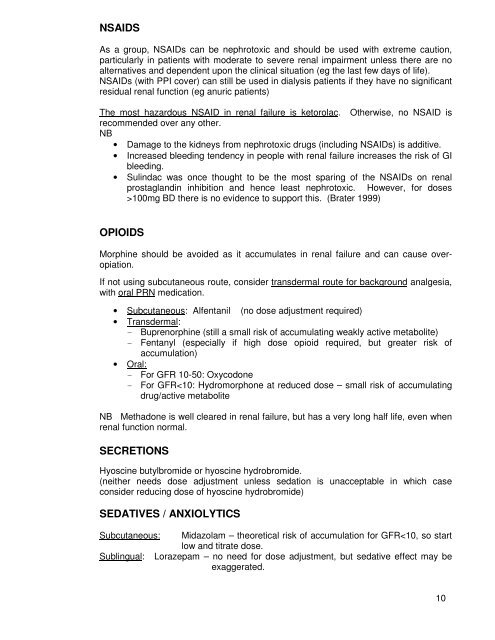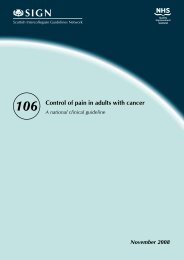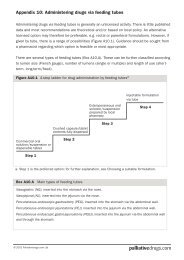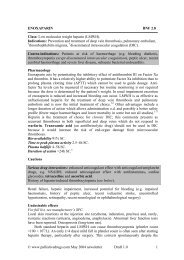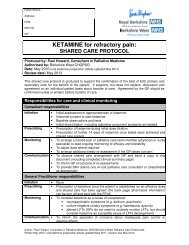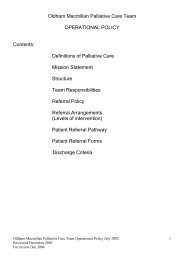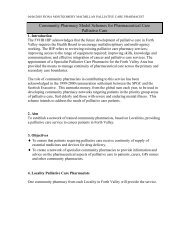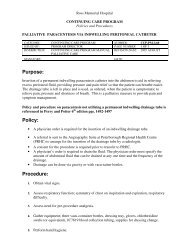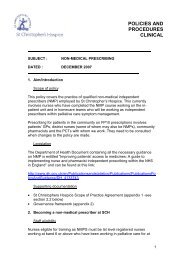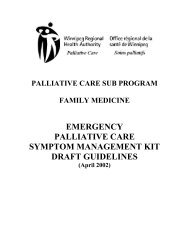Clinical Guidelines for the use of Palliative Care Drugs in Renal ...
Clinical Guidelines for the use of Palliative Care Drugs in Renal ...
Clinical Guidelines for the use of Palliative Care Drugs in Renal ...
Create successful ePaper yourself
Turn your PDF publications into a flip-book with our unique Google optimized e-Paper software.
NSAIDS<br />
As a group, NSAIDs can be nephrotoxic and should be <strong>use</strong>d with extreme caution,<br />
particularly <strong>in</strong> patients with moderate to severe renal impairment unless <strong>the</strong>re are no<br />
alternatives and dependent upon <strong>the</strong> cl<strong>in</strong>ical situation (eg <strong>the</strong> last few days <strong>of</strong> life).<br />
NSAIDs (with PPI cover) can still be <strong>use</strong>d <strong>in</strong> dialysis patients if <strong>the</strong>y have no significant<br />
residual renal function (eg anuric patients)<br />
The most hazardous NSAID <strong>in</strong> renal failure is ketorolac. O<strong>the</strong>rwise, no NSAID is<br />
recommended over any o<strong>the</strong>r.<br />
NB<br />
• Damage to <strong>the</strong> kidneys from nephrotoxic drugs (<strong>in</strong>clud<strong>in</strong>g NSAIDs) is additive.<br />
• Increased bleed<strong>in</strong>g tendency <strong>in</strong> people with renal failure <strong>in</strong>creases <strong>the</strong> risk <strong>of</strong> GI<br />
bleed<strong>in</strong>g.<br />
• Sul<strong>in</strong>dac was once thought to be <strong>the</strong> most spar<strong>in</strong>g <strong>of</strong> <strong>the</strong> NSAIDs on renal<br />
prostagland<strong>in</strong> <strong>in</strong>hibition and hence least nephrotoxic. However, <strong>for</strong> doses<br />
>100mg BD <strong>the</strong>re is no evidence to support this. (Brater 1999)<br />
OPIOIDS<br />
Morph<strong>in</strong>e should be avoided as it accumulates <strong>in</strong> renal failure and can ca<strong>use</strong> overopiation.<br />
If not us<strong>in</strong>g subcutaneous route, consider transdermal route <strong>for</strong> background analgesia,<br />
with oral PRN medication.<br />
• Subcutaneous: Alfentanil (no dose adjustment required)<br />
• Transdermal:<br />
- Buprenorph<strong>in</strong>e (still a small risk <strong>of</strong> accumulat<strong>in</strong>g weakly active metabolite)<br />
- Fentanyl (especially if high dose opioid required, but greater risk <strong>of</strong><br />
accumulation)<br />
• Oral:<br />
- For GFR 10-50: Oxycodone<br />
- For GFR


